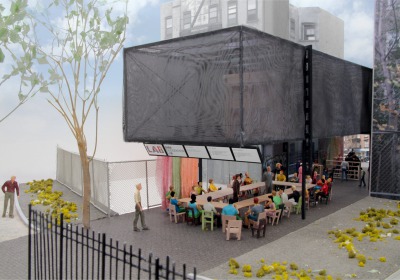BMW Guggenheim Lab
Fri, 20 May 2011With many surveys suggesting the world's automobile buyers are growing younger and more urban, saavy automobile companies are rushing to show their concern with cities, the future - and the future of cities. In New York City recently, black Audi A8s recently ferried 'influencers' to the Lower East Side area around the New Museum to attend an Audi supported Urban Future Initiative part of the area's Festival of Ideas.
The Volkswagen Group and the Museum of Modern Art promise a major announcement of future cooperation, on May 23, and BMW recently announced that it is supporting the Guggenheim Museum in a six-year, nine-city endeavor called the BMW Guggenheim Lab.
BMW and the Guggenheim say the program "will design public programs, experiments, and an installation exploring how interventions and innovations that decentralize, decelerate, localize, and democratize New Yorkers can reinvent the urban experience, creating a more adaptable and sustainable version of comfort."
Design is critical to the effort. The whole program involves three phases and three architects. An innovative evolving logo and graphic program has been devised by the South Korean firm Sulki & Min.
Opening on August 1 in New York, the lab is to "provide a public place and online forum for sharing ideas and practical solutions." The public events are free and the website is bmwguggenheimlab.org. Later efforts will be staged in Berlin and other cities.
In keeping with BMW's sophisticated cultural efforts - such as the Jeff Koons art car and the hiring of architects like Zaha Hadid and CoopHimmelb(l)au - the choice of the first architect is a smart and subtle one. The Japanese firm Atelier Bow-Wow has designed a building that will open this summer not far from the New Museum, in a now ragged city-owned lot on East First Street.
It is not entirely clear what will go on inside the building: discussion, thinking, programs; all devised by a network of experts.
The whole enterprise is directed by curators from the Guggenheim, David van der Leer, Assistant Curator, Architecture and Urban Studies, and Maria Nicanor, Assistant Curator, Solomon R. Guggenheim Museum. They will be advised by an international committee including a famous composer, a noted architect, two mayors, an economist, a theoretical physicist and others who will identify talented people to participate. The advisors include Daniel Barenboim, Elizabeth Diller, Muchadeyi Ashton Masunda, the Mayor of Harare, Zimbabwe and Enrique Peñalosa, the former Mayor of Bogotá, Colombia. The Guggenheim in New York will offer an exhibition based on the effort in 2013.
Atelier Bow-Wow offers an approach to design in the city that is apt for the neighborhood. The firm was established in Tokyo in 1992 by the husband-and-wife team of Yoshiharu Tsukamoto and Momoyo Kaijima. The pair is interested in the sort of odd but useful buildings that people wedge into tiny leftover spaces in the city. Atelier Bow-Wow calls these ‘pet buildings', but they might better be termed ‘mutts': that is inventive, odd structures for leftover city spaces. One favorite example is the Coffee Saloon Kimoto, a four seat triangular café in Tokyo.
The structure they have designed appears to be inspired by this spirit. It is a self-effacing multipurpose carbon fiber shelter, accompanied by wooden outbuildings. The architects describe it as a "traveling toolbox". Part loggia, part stage, it will be wrapped in semitransparent mesh with the upper area of wiring, lighting and so left visible.
Carbon fiber is an appropriate material, since BMW is giving great emphasis to carbon-reinforced plastic in the bodies of its upcoming i3 and i8 electric vehicles.
More information on this initiative can be found at the link below:
BMW Guggenheim Lab
By Phil Patton



